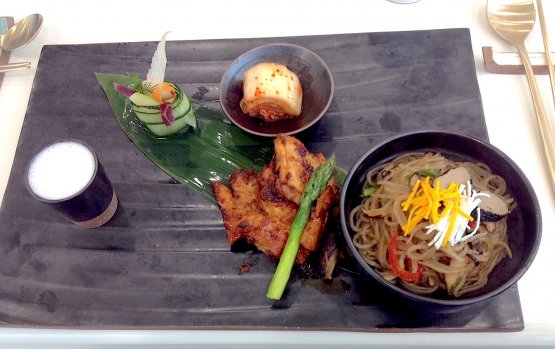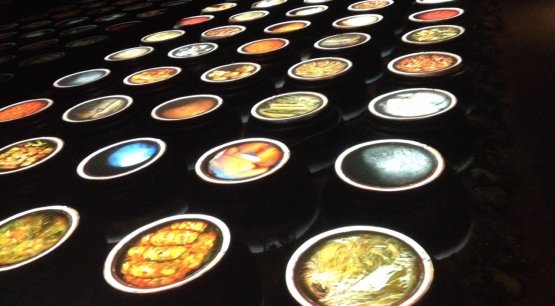We set foot outside our temporary restaurant for the first time to visit Korea’s pavilion, a short walk from our own Identità Expo. There are two main reasons: on the 21st May we will be in Seoul for a Gourmet Festival that is expected to be important (and includes lessons by our Massimo Bottura and Giorgio Nava from Cape Town). And most of all because the construction, not too far from the entrance to the Fair, had captured our notice with its oval and rounded lines, with a very elegant splendour.
We discover the architect was inspired by the Moon Jar, a typical Korean ceramic fully resembling Earth’s satellite, traditionally used to keep fermented food such as jeod-gal (sea fruits in salt) or jang (sauces and pastes). Fermentations, one of the irresistibly increasingly popular leitmotivs in world cuisine, have always characterised Korean cuisine. In the complex and shiny multimedia journey you find in the Corea pavilion (thus called, with no separation between North and South) has dozens and dozens of onggi scattered around, the traditional jars in which fermentation processes traditionally take place, which are here explained for what they are: the breaking down of organic matter with which a process of synthesis of new elements begins.

Inside the restaurant of Korea’s pavilion you can find specialties such as Bibimmyeon & kimchi soban, a slate picture which includes, clockwise, mushroom porridge (in the small glass), salad, kimchi (fermented cabbage), Korean noodles with white kimchi (bibimmyeon) and grilled chicken in soy sauce
Hundreds of
onggi, overflowing with audio-visual stimuli, illustrate the alternating seasons and the preservation of food, structured so that balance and harmony between the ingredients – a mini-mirror of the world – may prevail. A concept they summarise with
Hansik. This is also the name of the restaurant, on the ground floor of the pavilion, which has been very popular during the first 3 days. And this despite the three words with which it is promoted are not a magnet for our gourmets: harmony, healing, health. This, however, is the direction the West is taking and on which it still has much to learn from Asian wisdom (for further details, ask
Pietro Leemann).

Onggi, the multimedia urns inside Korea’s pavilion
So why not use this occasion to order
Bibimbap, the classic Korean bowl of steamed rice, covered with
namul (marinated vegetables), eggs (raw or fried), and pieces of meat? Perhaps with grilled beef chops in soy sauce (
galbijjim) on the side,
kimchi cabbage (=fermented with spices, a side dish that defines a fascinating universe, of which we will tell you at length from Seoul) and mushroom porridge, a surprising shot. Or ask how
mandu, Korean dumplings, differ from their Chinese or Asian equivalent. Or define the apparently unfathomable nature of
haemul pajeon, a sort of round shaped pancake with green peppers and sea fruits. They also call it "Korean pizza" and it is sometimes paired with
makgeolli, the traditional rice with wine.